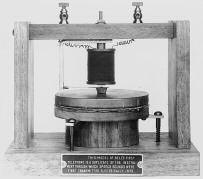Alexander Graham Bell (1847–1922) inventor
The inventor of the telephone was born in Scotland. As a boy and young man, Bell was interested in speech therapy and technologies that could help those with speech and hearing problems to communicate with others. He was exposed to these problems at an early age since both his father and grandfather were interested in communications. His grandfather, Alexander Bell, wrote a book on speech and elocution, and his father was a speech teacher in Dublin. Mabel Hubbard, his mother—and a painter—was deaf.
At age 23, Bell moved to Canada with his parents. A year later he began teaching at the Boston School for Deaf Mutes. After Morse developed the TELEGRAPH, Bell began to study electrical transmission and developed the idea of a “harmonic telegraph.” This sort of device, which led to the development of the telephone, envisaged sending more than one message along an electrical line directly to the recipient rather than a telegraph office, which would then have to forward a telegraph message by hand to the ultimate recipient. He teamed with Thomas WATSON, another inventor and proven technician. In 1875, they developed the first device capable of carrying sound along an electrical line. Within a year, Bell filed for a patent on his new device, which was granted on March 7, 1876. In the same year, the first telephone was introduced at the Philadelphia World’s Fair.

Bell formed the Bell Co., which became his vehicle for carrying out telephone development. After several legal skirmishes with WESTERN UNION TELEGRAPH CO., the Bell Co. emerged victorious from the courts and became the acknowledged leader in telephone systems. The Bell Co. and its smaller affiliates were consolidated as the AMERICAN TELEPHONE & TELEGRAPH CO. (AT&T) in 1878. Its first general manager was Theodore VAIL, who would resign but later return when the company was reorganized early in the 20th century. The Bell companies held most of the patents covering telephonic technology until the 1890s, when many of them began to expire, opening communications to competition.
In 1881, Bell won France’s Volta Prize and used the $10,000 award to set up the Volta Laboratory in Washington, D.C. He worked with two associates, his cousin Chichester Bell and Charles Sumner Tainter, at the laboratory, and their experiments soon produced major improvements in Thomas Edison’s phonograph, allowing it to become commercially viable.
After freeing himself from the day-to-day operations of his company, Bell continued research and inventing. One of his first innovations after the telephone was the photophone, a device allowing sound to be transmitted on a beam of light. Bell and Tainter developed the device, and in 1881, they successfully sent a photophone message over 200 yards from one building to another. Bell regarded the device as his greatest invention, even greater than the telephone. The photophone was the principle upon which laser and fiber-optic communication systems were later founded.
In 1907, four years after the Wright brothers first flew at Kitty Hawk, Bell formed the Aerial Experiment Association with four young engineers whose goal was to create airborne vehicles. By 1909, the group had produced four powered aircraft, one of which, the Silver Dart, made the first successful powered flight in Canada in 1909. Bell spent his later years improving hydrofoil designs, and in 1919, he and Casey Baldwin built a successful hydrofoil.
He also lent considerable support to National Geographic and Science magazines. When he died, the country’s telephone system went silent for a minute to honor him. He remains the most famous American inventor.
Further reading
- Bruce, Robert V. Bell: Alexander Graham Bell and the Conquest of Solitude. Ithaca, N.Y.: Cornell University Press, 1990.
- Grosvenor, Edwin S., Morgan Wesson, and Robert V. Bruce. Alexander Graham Bell: The Life and Times of the Man Who Invented the Telephone. New York: Harry Abrams, 1997.
- Mackay, James A. Alexander Graham Bell: A Life. New York: John Wiley & Sons, 1998.